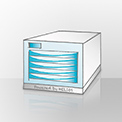HELIOS Tech Info #164
=======================================================
Update (Wed, 20 May 2015):
The following problem is solved by HELIOS update u1127.
=======================================================
Wed, 26 Nov 2014
HELIOS UB64 on EFI/UEFI boot configured systems
Starting with UB64 the HELIOS services on Mac, Linux or Windows no longer require a HELIOS USB dongle. The HELIOS MachID that is required for the license is generated from the BIOS identifier or MAC address.
On most EFI/UEFI systems, there is no BIOS identifier, so the HELIOS services will not get a HELIOS MachID without a USB dongle when using Linux or Windows.
Only EFI/UEFI boot configured servers are affected. HELIOS is working on a future update to support physical and virtual servers using EFI/UEFI.
Currently the following configurations/workarounds are needed:
EFI mode on VMware ESX / vSphere
=============================
VMware ESX / vSphere supports both BIOS and EFI.
To obtain a HELIOS MachID, make sure to choose BIOS as the boot firmware in the virtual machine settings.
EFI mode on Microsoft Hyper-V
========================
Microsoft Hyper-V in the latest versions (Windows Server 2012 and newer) supports both BIOS (Generation 1 virtual machine) and EFI systems (Generation 2 virtual machine).
To obtain a HELIOS MachID, a Generation 1 virtual machine is needed.
EFI/UEFI on physical machines
========================
On physical EFI/UEFI machines results may differ depending on the type of BIOS emulation. If no HELIOS MachID is provided, use the dongle workaround below.
Workaround using HELIOS USB dongle
===============================
On all machine types, when no HELIOS MachID can be generated from BIOS, you can use a traditional HELIOS USB dongle to provide a dongle MachID. A dongle MachID will always be preferred over the BIOS MachID.
Note that for this workaround on virtual machines the hypervisor must support passing through USB devices to virtual machines. On Microsoft Hyper-V, this is not supported without third-party tools.

 Enterprise Server
Enterprise Server
 Développeurs / SDK
Développeurs / SDK
 Industrie / Commerce
Industrie / Commerce
 Editeurs de journaux / Maisons d'édition
Editeurs de journaux / Maisons d'édition
 Photographes / Studios
Photographes / Studios
 Agences de communication / publicité
Agences de communication / publicité
 Vidéo & Divertissement
Vidéo & Divertissement
 Collaboration depuis le cloud
Collaboration depuis le cloud
 Couleur HD
Couleur HD
 Traitements d'images
Traitements d'images
 L'épreuvage
L'épreuvage
 Connectivité WebShare
Connectivité WebShare
 Automatisation de flux
Automatisation de flux
 Serveur de fichiers pour l'entreprise
Serveur de fichiers pour l'entreprise
 Communiqués de Presse
Communiqués de Presse Vidéos
Vidéos  Bulletins
Bulletins  Événements
Événements